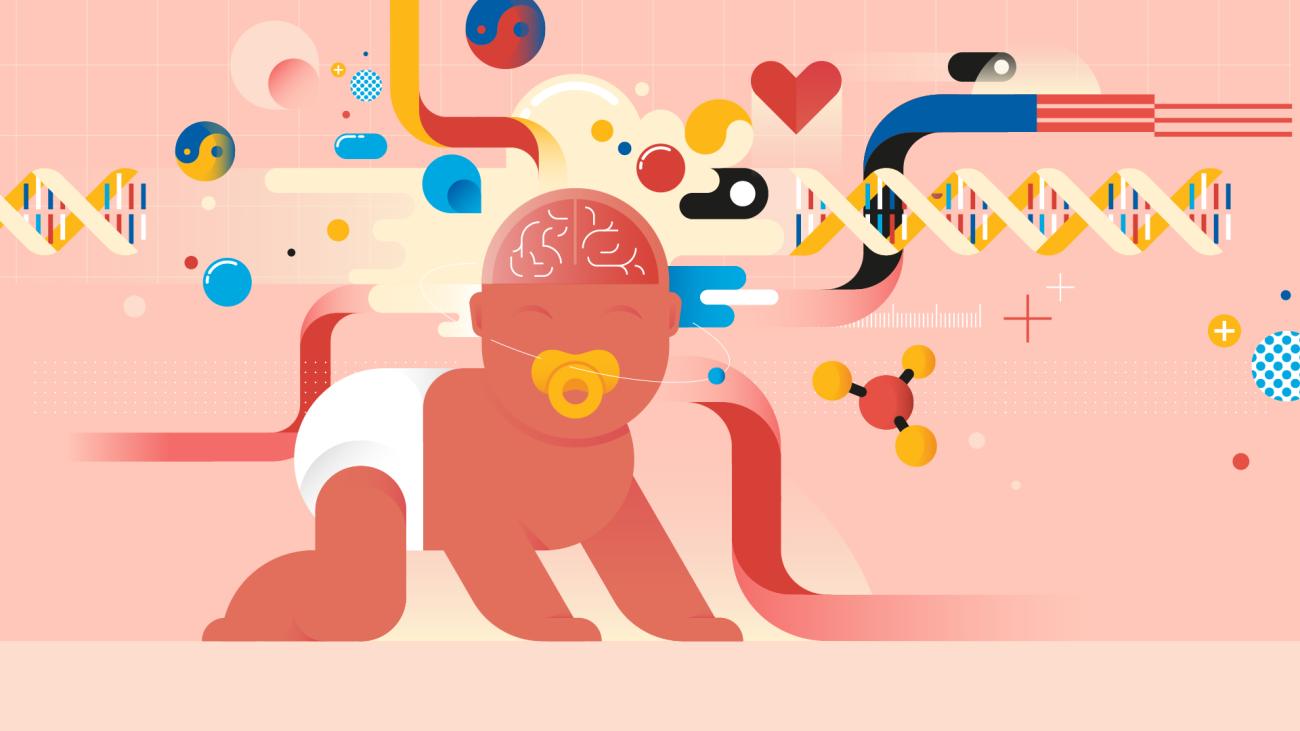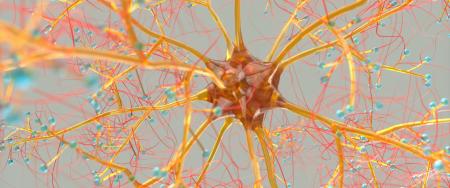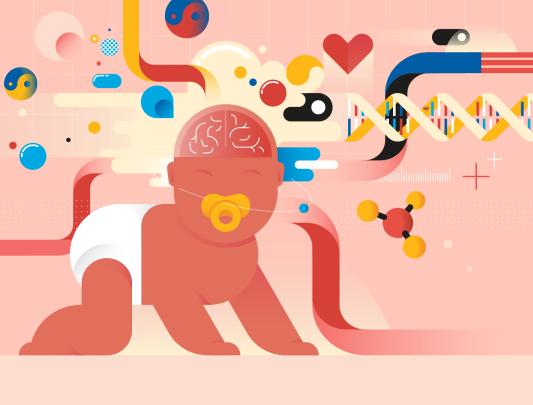
Illustrations by Fernando Volken Togni
Getting under the skin with epigenetics
Unravelling the mysteries of gene expression in early brain development.
It’s been 20 years since the completion of the Human Genome Project, one of the most ambitious and fruitful scientific endeavours in all of human history. The mapping of the human genome in 2003 engendered a new approach to biomedical research, laying out the complex musical score of our DNA that would allow us to discover, analyze, and even change the individual notes that make up the symphony of the human body.
If the genome is the score, then epigenetics is the orchestra – the combination of biological players in the body that determine how those notes are expressed. Just as an individual musician might play a measure more legato than is written on the sheet, an individual environmental factor might cause a gene to express itself differently in the human body, without any change to the underlying DNA. As an orchestra can play a score in a variety of different ways, epigenetic modifications – both natural and human-engineered – can alter the expression of genes in response to environmental cues, causing lasting effects on an individual’s health and well-being over the course of their life.
“There is an innate part of shaping the epigenome that happens from conception onwards in all of us,” says Dr. Michael Kobor, UBC professor of medical genetics. “There's pretty good evidence that there are certain sensitive periods during human development where given environments or experiences might exert a more profound effect on the epigenome. The best-studied sensitive periods are during early life, where a lot of the research has shown that if something happens to a growing child, it can get under the skin, as we like to say, and in part, be associated with different changes in the epigenome.”
THE PLASTICITY OF NEWBORN BRAINS
Kobor and his team have been working with Dr. Steven Miller – a neurologist who focuses on newborns, studying brain injury and brain development in babies who are critically ill, or born prematurely, or with congenital disease. They are seeking to understand the factors involved in gene expression during the early stages of life, particularly the epigenetics of brain development and how this affects brain health across the human lifespan.
The idea that we can rewind epigenetic changes and create positive epigenetic patterns speaks to the potential to not only slow down, but even reverse some of the negative effects of one’s environment, and possibly even aging itself.
“We've turned to epigenetics to understand potential ways in which a baby's everyday experience might influence the trajectory of their brain development,” says Miller, who heads the Department of Pediatrics at UBC. “The newborn brain is plastic, and there has been lots of outstanding work in neuroplasticity that shows how the immature or developing brain responds to changes in their environment.”
The notion of guiding plasticity in a newborn brain is an even more recent development than human genome mapping. The newborn brain has specific vulnerabilities to injury from things like perinatal asphyxia – a lack of blood flow or oxygen at birth. Where once it was believed such injuries had fixed outcomes, research has shown that these injuries can be prevented or even reversed by changing environmental factors.
For instance, full-term babies with perinatal asphyxia can now be treated in a newborn intensive care unit, where they are cooled to 33.5 degrees for 72 hours. This process, known as therapeutic hypothermia, slows down the metabolism, decreases excitatory neurotransmission, and has other positive effects that aren’t completely understood, ultimately decreasing mortality and reducing significant neurodevelopmental disability.
“If you had told me at the start of my career that there would be a treatment for perinatal asphyxia,” says Miller, “I would have thought that that was just science fiction.”
GENES EXPRESSING THEMSELVES
The current frontier of epigenetic studies is how gene expression influences the transformation of the brain across childhood, and the trajectory of childhood brain maturation that sets up brain health for the life course. At the centre of this work is an understanding of DNA methylation – how the addition of a methyl chemical group to a DNA molecule affects gene expression – which can have significant impacts on the body's overall functioning and health.
DNA methylation can be thought of as the orchestra’s conductor, guiding the individual musicians in how they express the score. In the early stages of brain development, billions of neurons form trillions of connections, largely guided by the methyl chemical groups that attach to DNA and histone proteins.
When a methyl group is added to a DNA molecule, it can modify the gene's expression by either turning it on or off – a process known as epigenetic regulation – which plays a critical role in controlling the body's gene expression patterns.
Methylation is also involved in many other physiological processes in the body, including DNA repair and the regulation of cell growth and division. Certain lifestyle factors can affect methylation patterns, and some of these changes have been associated with health conditions, including cancer, autoimmune disorders, and neurological disorders.
Gene expression across a lifetime can be influenced by a broad variety of factors, ranging from diet and exercise to socioeconomic status. Researchers can actually see an epigenetic pattern related to growing up in poverty for the first three or four years of life, even if that given person no longer lives in poverty as an adult.
The collaboration between Miller and Kobor zeroes in on these early epigenetic patterns by focusing on the effects a critical-care environment has on a preterm newborn with medical issues. “How does the everyday experience of babies born prematurely and requiring critical care influence the trajectory of brain development?” asks Miller. “Whether it's the pain that they’re exposed to, the injuries that they acquire, infections, being on a ventilator, or medications – each of these things contributes to this trajectory of brain health, either negatively or positively.”
To understand the lasting impact of these early-life exposures – or how they might be mitigated through epigenetic alterations – Miller and his colleagues also study the children’s environments as they grow. “What's happening in these homes that is promoting brain repair and supporting this trajectory of brain development?” adds Miller. “Our hypothesis is that pathways that may be involved are things like exposure to reading, nutrition, and maybe even exercise. We're starting to ask, what are the pathways by which we're seeing these really improved outcomes beyond what you would have expected from the neuroscience? Is that mediated by epigenetics?”
ALTERING GENE EXPRESSION
As important as early brain development is to overall health, epigenetic markers can be changed across the entire lifespan. Smokers, for instance, have less DNA methylation than non-smokers at certain parts of the AHRR gene (a gene that plays a critical role in the body’s response to environmental pollutants and the regulation of immune system functions). But if you give up smoking for a year, you can increase your DNA methylation, even bringing it back to the regular level of non-smokers.
“These methylation marks on the genes kind of act like a dimmer switch,” says Kobor, who holds the Canada Research Chair in Social Epigenetics, and has recently become the inaugural Edwin S.H. Leong UBC Chair in Healthy Aging. “If you can play with that dimmer by changing your environment or by changing your behaviour, you change the level of gene expression.”
In some cases, changes in methylation patterns may be chemically reversible. Using modified versions of the technology behind CRISPR – a gene-editing tool that allows precise editing of DNA sequences – scientists are already able to add methyls to DNA in a test tube, altering the expression of the AHRR gene to “raise the dimmer switch” and restore proper gene expression that was suppressed by smoking. The idea that we can rewind epigenetic changes and create positive epigenetic patterns speaks to the potential to not only slow down, but even reverse some of the negative effects of one’s environment, and possibly even aging itself.
The future of medicine is likely some combination of these two scientific frontiers, with both CRISPR technology and epigenetic research offering vast possibilities in preventive and corrective healthcare. Using precise interventions tailored to an individual's unique DNA and epigenetic profile, doctors will be able to control both the musicians and the orchestra, keeping everyone’s body and brain in tune.
ONLY AS OLD AS YOU FEEL
The field of epigenetics may even challenge the concept of age itself. Just as previous decades have recognized the complexity of race and fluidity of gender, the cutting edge of Kobor’s research focuses on “epigenetic clocks” – two dozen or so methylation patterns in the human body that allow us to measure biological age not chronologically, but chemically. As each epigenetic clock is based on hundreds of methylation sites (out of approximately 28 million options), the potential combinations – and the information each combination could reveal – is practically infinite.
“I have become so fascinated by the epigenetic clock,” says Kobor. “I think it will be an amazing tool to create a deeply interdisciplinary research framework that will ultimately have a place in healthcare.”
So far, epigenetic clocks have proven to be reliable predictors of health outcomes, with older epigenetic age showing a higher risk for age-related diseases such as Alzheimer's and cardiovascular disease. The technique can also be used to quantify the individual effects of environmental factors on a person’s biological age, such as exposure to pollution, stress, and poor nutrition accelerating epigenetic aging, and healthy lifestyle habits such as exercise, a balanced diet, and stress reduction slowing it down.
Although fully stopping or reversing one’s epigenetic age is a dream of the distant future, the promise of epigenetic research bringing about an era of “healthy aging” is already being realized in Kobor’s lab, where targeted lifestyle interventions that reduce one’s epigenetic age can delay or prevent otherwise inevitable age-related diseases.
“We are still in the very early days of this research,” says Kobor. “I think why people get so excited about epigenetics is that it provides a fairly advanced picture of how experiences can get under the skin, and fits very neatly in the nature and nurture debate. What we need now is recurring genetic testing over a lifespan to see how changing epigenetic patterns relate to a given environment, a given experience, or a particular exposure.”
The initial years of life represent a remarkable period of growth and transformation for the human brain. As the foundation for lifelong cognitive, emotional, and social abilities takes shape, early brain development holds the key to unlocking our full potential. By exploring some of the most captivating aspects of this vital developmental stage, we can better understand the intricate processes that shape who we become.

A Dynamic Start
Even before birth, the brain is already hard at work. The neural tube, which eventually develops into the brain and spinal cord, begins forming just three weeks after conception.

Sensory Priorities
During infancy, the brain prioritizes the development of sensory and motor regions. This allows babies to rapidly learn about their environment through touch, taste, smell, sight, and sound, and helps them acquire essential motor skills.

Language Window
Early exposure to language is crucial for children. By age five, their brains have established strong neural pathways for understanding and speaking their native language, making this period vital for language development.

Social Connections
The brain's social and emotional areas develop rapidly in the first few years of life. Through interaction and bonding with caregivers, infants learn to recognize faces, interpret emotions, and form attachments.

Power of Play
Playtime is more than just fun for young children; it's essential for brain development. Engaging in play activities helps strengthen neural connections and promotes cognitive, social, and emotional growth.

Sleep's Role
Adequate sleep is vital during early childhood. Sleep helps consolidate memories, promotes learning, and supports the brain's ongoing development.

Brain Plasticity
The young brain is highly adaptable, thanks to a phenomenon called neuroplasticity. This enables children to learn and adjust quickly to new experiences and challenges, setting the stage for a lifetime of growth and discovery.

































